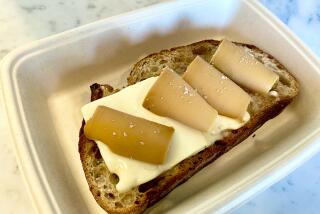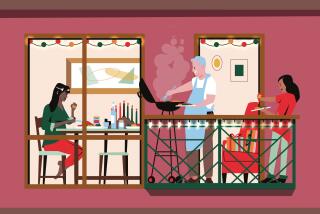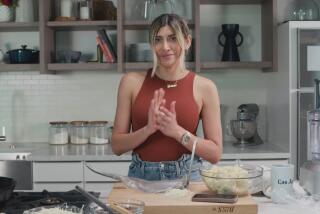Test Kitchen video tip: Choosing a bread wash
Bread recipes often call for some sort of “wash” or glaze before baking, sometimes egg, sometimes milk. Even butter. Different washes are used to achieve different results:
- Brushing with beaten whole eggs will give color and sheen to a bread. Egg yolk provides rich color, browning easily in the oven. Egg white provides a nice sheen.
- Brushing with milk will help color the crust, the sugars in the milk helping to brown the crust.
- Water is often sprayed or brushed onto bread before it is placed in a very hot oven, and during baking, to give the bread an extra-crisp crust. Water added to an egg wash helps to thin the wash so it brushes more easily.
- Butter will give the bread a softer crust and richer flavor.
- Sweeteners -- honey, syrup, etc. -- will give bread a sweeter, softer crust.
If you have any kitchen tips or questions you’d like me to explore, leave a comment below or shoot me an e-mail at noelle.carter@latimes.com.
ALSO:
Go behind the scenes at the Test Kitchen
134 recipes for your favorite restaurant dishes
Browse hundreds of recipes from the L.A. Times Test Kitchen
You can find Noelle Carter on Facebook, Google+, Twitter and Pinterest. Email her at noelle.carter@latimes.com.
Black Russian rye bread
Total time: 1 1/2 hours, plus rising and cooling times
Servings: Makes 2 loaves (about 16 servings)
Note: Adapted from “The Bread Bible” by Beth Hensperger. Specialty flours are available at select well-stocked markets, health food, cooking and baking supply stores, as well as online.
2 (1/4-ounce) packages (1 1/2 tablespoons) active dry yeast
Pinch of sugar
2 1/2 cups warm water (105 to 115 degrees), divided
1/2 cup dark molasses (not blackstrap)
1/4 cup apple cider vinegar
1/4 cup (1/2 stick) butter
1 ounce unsweetened chocolate
1/2 cup (2.25 ounces) whole wheat flour
3 cups (12 ounces) rye flour
3 cups unbleached all-purpose (12.75 ounces) or bread (13.5 ounces) flour plus 1 tablespoon unbleached all-purpose flour, divided
1 cup wheat bran
2 tablespoons caraway seeds, plus 1 optional teaspoon, divided
1/2 teaspoon fennel seeds
1 tablespoon salt
1 tablespoon instant espresso powder
1 tablespoon minced shallots
1/4 cup cornmeal
1. In a small bowl, sprinkle the yeast and sugar over one-half cup of warm water. Stir to dissolve and let stand at room temperature until foamy, about 10 minutes.
2. In a small saucepan, gently heat the remaining 2 cups water, molasses, vinegar, butter and chocolate until the butter and chocolate are melted, stirring frequently. Set aside to cool to lukewarm.
3. In a large bowl, whisk together the whole wheat, rye and all-purpose flours (except the 1 remaining tablespoon of all-purpose). Set aside.
4. In the bowl of a stand mixer fitted with a paddle attachment, combine 2 cups of the mixed flours, the bran, 2 tablespoons caraway seeds, fennel seeds, salt, espresso powder and shallots. Over low speed, add in the yeast and chocolate mixtures. Mix until smooth and beat at medium speed for 3 minutes. (If you don’t like whole seeds in your bread, grinding them in a spice grinder, coffee grinder or mortar and pestle allows their flavor to come through without the texture.)
Alternatively, this or any bread, can also be made by hand, simply mixing the ingredients in a large bowl with a wooden spoon and kneading the dough on a counter until springy and smooth. But for doughs heavy with whole grain flours, the stand mixer works the best.
5. At low speed, add one-half cup of the remaining mixed flours at a time, just until the dough clears the sides of the bowl and begins to work its way up the paddle. It will be very sticky but firm. Be careful not to add too much flour. The dough will spring back when pressed.
6. Scrape the dough off the paddle and place on a well-floured counter or large surface. Continue to knead by hand to make a smooth and springy yet dense dough. If you prefer, you can switch to the dough hook and knead again over low speed for 2 to 3 minutes, then finish off a few kneads by hand. You might not use all of the flour mixture.
7. Form into a ball and place in a greased deep container, such as a plastic bucket. Turn once to grease the top. Cover with plastic wrap and set aside to rise in a warm area until doubled, about 1 1/2 to 2 hours. Meanwhile, combine the cornmeal, remaining tablespoon of flour and remaining teaspoon of caraway seeds, if using, and set aside. Heat the oven to 350 degrees.
8. On a parchment-lined baking sheet, sprinkle the cornmeal mixture. Gently deflate the dough. Turn out the dough onto a lightly floured surface. Divide the dough into two portions. Stretch each portion into a ball, pulling the edges and pinching to form a seam. Place the formed rounds, seam side down, on the baking sheet. Cover loosely with plastic wrap (you can spray the plastic with nonstick cooking spray). Set aside to rise until puffy and almost doubled in bulk, 45 minutes to 1 hour. With a serrated knife, gently slash an X into the top of a round no more than one-fourth inch deep.
9. Bake the loaves until they are crusty and sound hollow when tapped on the bottom, 45 to 50 minutes. It is difficult to see the loaves browning because they are so dark-colored. If you are checking with a thermometer, they should read 200 to 210 degrees on an instant-read thermometer. Remove the loaves from the baking sheet to cool completely on a rack. Cool completely before slicing.
Each of 16 servings: 258 calories; 7 grams protein; 50 grams carbohydrates; 6 grams fiber; 5 grams fat; 3 grams saturated fat; 8 mg cholesterol; 6 grams sugar; 443 mg sodium.
More to Read
Eat your way across L.A.
Get our weekly Tasting Notes newsletter for reviews, news and more.
You may occasionally receive promotional content from the Los Angeles Times.







